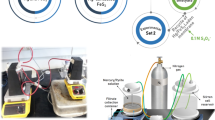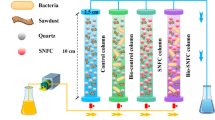Abstract
Chromium pollution in ground water is already very serious and needs to be solved urgently. In the present work, the products of natural pyrite after heat treatment were used as the reactive media for permeable reactive barrier. It found that natural pyrite can progressively convert to pyrrhotite with mixed monoclinic and hexagonal structures or pure hexagonal structure at different heat temperatures in argon atmosphere. The products heated at 600 °C had the highest removal of Cr6+ as compared to pristine pyrite and other heated products. The column experiment showed the service life of the column was 480 PVs. The removal of Cr6+ mechanisms under the batch and column conditions were also investigated in detail and both of them were redox reactions. The present work suggested that heat-treated natural pyrite has good application prospect as an efficient and low-cost reactive media material in permeable reactive barrier for chromium pollution control.









Similar content being viewed by others
References
Aredes S, Klein B, Pawlik M (2012) The removal of arsenic from water using natural iron oxide minerals. J Clean Prod 29–30:208–213
Balasubramanian S, Pugalenthi V (1999) Determination of total chromium in tannery waste water by inductively coupled plasma-atomic emission spectrometry, flame atomic absorption spectrometry and UV–visible spectrophotometric methods. Talanta 50:457–467
Barri CD (2010) Pyrite—’fool’s gold’ or misunderstood mineral? Geol Today 26:28–33
Belzile N, Chen Y, Cai M, Li Y (2004) A review on pyrrhotite oxidation. J Geochem Explor 84:65–76
Bergeson A, Reed T, Apblett A (2020) Reduction and immobilization of chromate using nanometric pyrite. J Mater Eng Perform 29:5557–5563
Chen T, Shi Y, Liu H, Chen D, Li P, Yang Y, Zhu X (2016) A novel way to prepare pyrrhotite and its performance on removal of phosphate from aqueous solution. Desalin Water Treat 57:23864–23872
Chen T, Yan Y, Dong C, ** L, **ao Z (2013) Structural evolution of heat-treated colloidal pyrite under inert atmosphere and its application for the removal of Cu(II) ion from wastewater. Environ Eng Manag J 12:1411–1416
Chen T, Yang Y, Li P, Liu H, **e J, **e Q, Zhan X (2014) Performance and characterization of calcined colloidal pyrite used for copper removal from aqueous solutions in a fixed bed column. Int J Miner Proces 130:82–87
Du L, Zhang L, Li W, Fang F (2007) Removal of heavy metal ions from groundwater by permeable reactive barrier. Environ Pollut Control 8:578–582
Faisal A, Sulaymon A, Khaliefa Q (2017) A review of permeable reactive barrier as passive sustainable technology for groundwater remediation. Int J Environ Sci Tech 15:1123–1138
Fallico C, Troisi S, Molinari A, Rivera M (2010) Characterization of broom fibers for PRB in the remediation of aquifers contaminated by heavy metals. Biogeosciences 7:2545–2556
Fiore S, Zanetti M (2009) Preliminary tests concerning zero-valent iron efficiency in inorganic pollutants remediation. Am J Environ Sci 5:556–561
Gibert O, Assal A, Devlin H, Elliot T, Kalin RM (2019) Performance of a field-scale biological permeable reactive barrier for in-situ remediation of nitrate-contaminated groundwater. Sci Total Environ 659:211–220
Gillham RW, Vogan J, Gui L, Duchene M, Son J (2010) Iron barrier walls for chlorinated solvent remediation. In: Stroo HF, Ward CH (eds) In situ remediation of chlorinated solvent plumes. Springer, New York, pp 537–571
Guan X, Sun Y, Qin H, Li J, Lo I, He D, Dong H (2015) The limitations of applying zero-valent iron technology in contaminants sequestration and the corresponding countermeasures: the development in zero-valent iron technology in the last two decades (1994–2014). Water Res 75:224–248
Guo Q, Liao L, Mei L, Liu H (2016) Color-Tunable Photoluminescence and Energy Transfer Properties of Single-Phase Ba10(PO4)6O:Eu2+, Mn2+ Phosphors.". J Solid State Chem 47:102–107
Han Y, Gallegos TJ, Demond AH, Hayes KF (2011) FeS-coated sand for removal of arsenic(III) under anaerobic conditions in permeable reactive barriers. Water Res 45:593–604
Hashim MA, Mukhopadhyay S, Sahu JN, Sengupta B (2011) Remediation technologies for heavy metal contaminated groundwater. J Environ Manage 92:2355–2388
Henderson AD, Demond AH (2013) Permeability of iron sulfide (FeS)-based materials for groundwater remediation. Water Res 47:1267–1276
Ishag A, Li Y, Zhang N, Wang H, Guo H, Mei P, Sun Y (2020) Environmental application of emerging zero-valent iron-based materials on removal of radionuclides from the wastewater: a review. Environ Res 188:109855
Lambert JM, Simkovich G, Walker PL (1998) The kinetics and mechanism of the pyrite-to-pyrrhotite transformation. Metall Mater Trans B 29:385–396
Li P, Chen T, Yang Y, **e Q, **e J (2013) Effect of heat treatment in nitrogen on mineralogy characteristics of colloidal pyrite. J Chin Ceram Soc 41:1564–1570
Li S, You T, Guo Y, Yao S, Zang S, **ao M, Zhang Z, Shen Y (2019) High dispersions of nano zero valent iron supported on biochar by one-step carbothermal synthesis and its application in chromate removal. RSC Adv 9:12428–12435
Li Y, Huang Y, Wu W, Yan M, **e Y (2021) Research and application of arsenic-contaminated groundwater remediation by manganese ore permeable reactive barrier. Environ Technol 42:2009–2020
Liao Y, Chen D, Zou S, **ong S, **ao X, Dang H, Chen T, Yang S (2016) Recyclable naturally derived magnetic pyrrhotite for elemental mercury recovery from flue gas. Environ Sci Tech 50:10562–10569
Lin Y, Huang C (2008) Reduction of chromium (VI) by pyrite in dilute aqueous solutions. Sep Purif Technol 63(1):191–199
Liu Y, Mou H, Chen L, Mirza ZA, Liu L (2015) Cr(VI)-contaminated groundwater remediation with simulated permeable reactive barrier (PRB) filled with natural pyrite as reactive material: Environmental factors and effectiveness. J Hazard Mater 298:83–90
Lu P, Chen T, Liu H, Li P, Peng S, Yang Y (2019) Green preparation of nanoporous pyrrhotite by thermal treatment of pyrite as an effective Hg(II) adsorbent: performance and mechanism. Minerals 9:74
Lu X, Lu A, Chen J, Tang J, Yao Z (2000) Characteristics of pH variation in the Cr(VI)-bearing wastewater disposed by clino-pyrrhotite and hexa-pyrrhotite. Geolog J China Univer 6:271–277
Maamoun I, Eljamal O, Falyouna O, Eljamal R, Sugihara Y (2020) Multi-objective optimization of permeable reactive barrier design for Cr(VI) removal from groundwater. Ecotox Environ Safe 200:110773
Minia GA, Mokhtarani N (2018) Remediation of nitrate-contaminated groundwater by PRB-Electrokinetic integrated process. J Environ Manage 222:234–241
Park M, Park J, Kang J, Han Y, Jeong H (2018) Removal of hexavalent chromium using mackinawite (FeS)-coated sand. J Hazard Mater 360:17–23
Powell RM, Puls RW, Blowes DW, Gillham RW, Schultz D (1998) Permeable Reactive Barrier Technologies for Contaminant Remediation. Interim report, United States.
Puls RW, Paul CJ, Powell RM (1999) The application of in situ permeable reactive (zero-valent iron) barrier technology for the remediation of chromate-contaminated groundwater: a field test. Appl Geochem 14:989–1000
Pupeza M, Cernik M, Greco M (2007) Dechlorination of chlorinated hydrocarbons by zero-valent iron nano-particles. In: Marmiroli N, Samotokin B, Marmiroli M (eds) Advanced science and technology for biological decontamination of sites affected by chemical and radiological nuclear agents. Springer, New York, pp 111–118
Qiu Y, Zhang Q, Gao B, Li M, Fan Z, Sang W, Hao H, Wei X (2020) Removal mechanisms of Cr(VI) and Cr(III) by biochar supported nanosized zero-valent iron: Synergy of adsorption, reduction and transformation. Environ Pollut 265:115018
Rowbotham AL, Levy LS (2000) Chromium in the environment: an evaluation of exposure of the UK general population and possible adverse health effects. J Toxicol Environ Health B Crit Rev 3:145–178
Safonov A, Popova N, Andrushenko N, Boldyrev K, Yushin N, Zinicovscaia I (2020) Investigation of materials for reactive permeable barrier in removing cadmium and chromium(VI) from aquifer near a solid domestic waste landfill. Environ Sci Pollut Res Int 28:1–15
Shi J, Lu A, Lu X (1999) Experiments on treatment of Cr(VI)-containing waste water by natural and modified pyrite. Bull Mineral Petrol Geochem 18:226–229
Shi Y, Chen T, Li P, Zhu X, Yang Y (2015) The phase transition of pyrite thermal decomposition in nitrogen gas. Geolog J China Univer 4:577–583
Singh R, Misra V, Singh RP (2012) Removal of hexavalent chromium from contaminated ground water using zero-valent iron nanoparticles. Environ Monit Assess 184:3643–3651
Wang J, Hou L, Yao Z, ** JY, Ni S, Zhang L (2020a) Aminated electrospun nanofiber membrane as permeable reactive barrier material for effective in-situ Cr(VI) contaminated soil remediation. Chem Eng J 406:126822
Wang F, Xu W, Xu Z, Liu H (2020b) CTMAB-modified bentonite-based PRB in remediating Cr(VI) contaminated groundwater. Water Air Soil Pollut 231:20
Yaacob WZ, Kamaruzaman WN, Rahim A (2012) Development of nano-zero valent iron for the remediation of contaminated water. Chem Eng 28:25–30
Yang Y, Chen T, Li P, Liu H, **e J, **e Q, Zhan Z (2014) Removal and recovery of Cu and Pb from single-metal and Cu–Pb–Cd–Zn multimetal solutions by modified pyrite: fixed-bed columns. Ind Eng Chem Res 53:18180–18188
Zhairy A, Adra A, Ghafar M (2020) Cr(VI) removal from tannery wastewater by Syrian natural pyrite as a reducing agent. Int J Sci Res 7:1–5
Zhao C, Wu B, Chen J (2015) Electronic structure and flotation behavior of monoclinic and hexagonal pyrrhotite. J Cent South Univer 22:466–471
Zouboulis AI, Kydros KA, Matis KA (1995) Removal of hexavalent chromium anions from solutions by pyrite fines. Water Res 29:1755–1760
Acknowledgements
This work was supported by the Natural Science Foundation of China (Grant Number 41831288).
Author information
Authors and Affiliations
Contributions
HL and LL contributed to the study conception and design. Material preparation, data collection and analysis were performed by BZ, ZL and YL. The first draft of the manuscript was written by BZ. Revision of the article was done by HL and LL. All authors read and approved the final manuscript.
Corresponding authors
Ethics declarations
Conflict of interest
The authors declare that they have no conflict of interest.
Additional information
Editorial responsibility: Senthil Kumar Ponnusamy.
Supplementary Information
Below is the link to the electronic supplementary material.
Rights and permissions
Springer Nature or its licensor (e.g. a society or other partner) holds exclusive rights to this article under a publishing agreement with the author(s) or other rightsholder(s); author self-archiving of the accepted manuscript version of this article is solely governed by the terms of such publishing agreement and applicable law.
About this article
Cite this article
Zhou, B., Liu, Z., Li, Y. et al. Removal of hexavalent chromium pollutant and mechanism by heat-treated natural pyrite as an efficiency reactive media for permeable reactive barrier. Int. J. Environ. Sci. Technol. 21, 1537–1548 (2024). https://doi.org/10.1007/s13762-023-05056-8
Received:
Revised:
Accepted:
Published:
Issue Date:
DOI: https://doi.org/10.1007/s13762-023-05056-8




